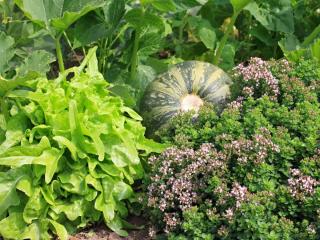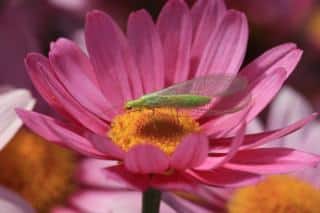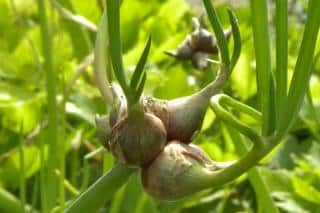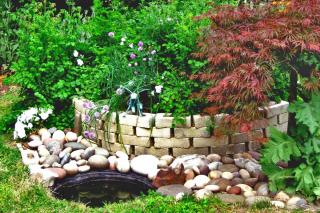

In permaculture, nature does all the work! For a permaculture garden to be sustainable, self-sufficient and properly balanced, it’s important to favor biodiversity. Plants of course, especially cultivated crops, but also that of animals both wild and domesticated. Long-lasting trees and perennials or self-sowing plants help out, too.
Read also:
Biodiversity, together with the fostering of life and soil fertility, is the single most important aspect of permaculture. Diversity ensures balance, even more so when it’s happening within a permaculture garden. In itself, it’s a goal to aim for when considering crops and animals.
 Permaculture rarely uses straight lines for sowing, and never dedicates a growing area to only a single species of plant. From afar, such a garden would actually seem a happy, bustling mess, highly diversified and very abundant. However, companion plants (flowers, vegetables, herbs, shrubs, trees) are all carefully selected to trigger mutually beneficial interactions: some plants protect others from pests, others share their cool shade, and others still attract pollinating insects and pest controllers. This is the basic concept of companion planting.
Permaculture rarely uses straight lines for sowing, and never dedicates a growing area to only a single species of plant. From afar, such a garden would actually seem a happy, bustling mess, highly diversified and very abundant. However, companion plants (flowers, vegetables, herbs, shrubs, trees) are all carefully selected to trigger mutually beneficial interactions: some plants protect others from pests, others share their cool shade, and others still attract pollinating insects and pest controllers. This is the basic concept of companion planting.
Moreover, having lots of different species in the same area completely disrupts pests – these love monoculture gardens! – so invasive pests are very much reduced. In the same manner, diseases don’t propagate as easily when their host plants are shielded by other inhospitable neighbors. It gets harder for disease-bearing fungus and parasites to hop from one plant to the next, unlike what happens in single-crop plots!
Often, in permaculture, growing space is limited. The goal is to grow as many plants as you can on the smallest possible space. One way of doing this is to grow crops on several levels at once (trellis, stakes…).
 Attracting many different types of insects and animals in the garden is an excellent way to guard against natural predators and plant pests. To make this happen, of course all pesticides must be banished, even natural organic ones. The garden itself is designed to attract the right animals to the right place.
Attracting many different types of insects and animals in the garden is an excellent way to guard against natural predators and plant pests. To make this happen, of course all pesticides must be banished, even natural organic ones. The garden itself is designed to attract the right animals to the right place.
Hedges, stone walls, piles of old wood, wild growing areas, ponds and melliferous flowers should strategically dot the garden. Some beneficial insects such as green lacewing eat pollen when they’re adults… but their larva are definitely carnivorous and will devour all sorts of aphids, scale insects and thrips! Also, lots of solitary bees, wasps and bumblebees will come live nearby if you set up an insect hotel for them. Aside from insects, there are many other insect-eating animals: birds, toads, frogs, lizards, hedgehogs and even bats are amazing hunters.
Typically, permaculture involves chickens. Eggs aren’t the only thing they produce, by far: their droppings are packed with nitrogen, and as they scrimmage around the garden, they pick off any slug, snail and insect they lay their eyes on.
If the space permits, you can even add sheep and goats. These natural lawn mowers don’t pollute at all, and their manure actually makes the world a better place!
Trying to plant anything that isn’t native to the climate or soil type is definitely a no-go for advised gardeners. Compensating for the natural environment is tiresome and unsuccessful in the long run. A great way to have only minimal work and care is to select plants that are already suited to the area. It’ll alleviate every single chore you can imagine: watering, shading, drainage, cold hardiness, winterizing… Having hardy varieties, early bloomers, late crops, drought-resistant plants, heat-resilient plants, those that can cope with early frosts, and matching varieties with alkaline, acidic, clay or sandy soil will make life easier.
Self-sufficiency is one of the goals of permaculture, so growing a self-sustaining garden is one of the goals to reach. Avoid hybrid crops or varieties like the plague: they usually aren’t bred to be stable across generations, if they’re even fertile at all. Infertile hybrids won’t produce seeds at all; unstable varieties will produce seeds, but they will sprout to bear plants that aren’t productive, won’t resist disease, and are generally much inferior. Much better, on the other hand, are heirloom varieties: thanks to these, as a gardener, you can produce your own seeds without having to buy them again year after year.
 Complementary to these are, as always, perennials. These produce fruit (or flowers in the case of ornamentals) for several years on end. Some good examples are artichoke, asparagus, rhubarb, sorrel, spinach, perennial leek, tree onion, celery, lovage, Daubenton cabbage… and also those plants that have roots that grow anew if left in the ground: crosne, Jerusalem artichoke…
Complementary to these are, as always, perennials. These produce fruit (or flowers in the case of ornamentals) for several years on end. Some good examples are artichoke, asparagus, rhubarb, sorrel, spinach, perennial leek, tree onion, celery, lovage, Daubenton cabbage… and also those plants that have roots that grow anew if left in the ground: crosne, Jerusalem artichoke…
Such vegetables truly help save on work: no sowing needed, no transplanting. They’re also often more affordable than annuals. Similarly, plants that re-seed themselves on their own are also very much appreciated!
 A permaculture garden, when mature, is virtually a perennial system that’s virtually self-sufficient; the gardener is more of a caretaker, tweaking small things here and there. There isn’t any massive upheaval every season, since all the conditions are brought together for work to get done by nature itself!
A permaculture garden, when mature, is virtually a perennial system that’s virtually self-sufficient; the gardener is more of a caretaker, tweaking small things here and there. There isn’t any massive upheaval every season, since all the conditions are brought together for work to get done by nature itself!
This type of gardening doesn’t however mean that the garden will stay put without changing; much the opposite, actually. Plants reproduce on their own, slowly shift from one place to another that suits them better, animals appear, and, as a gardener, you’ll constantly be trying new things out, removing what doesn’t work…
A permaculture garden turns into a real-life observatory bustling with activity.
When a problem arises, observe and see which animals and plants are already helping solve it. Then, make life easier for those specific helpers and they’ll do the heavy work for you!